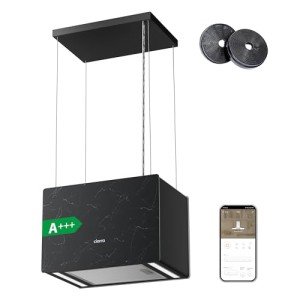5 Killer Quora Answers To Extractor Fan Kitchen Island
Island Hoods: An Overview of Their Purpose, Styles, and BenefitsIsland hoods have become a popular choice in modern-day kitchen style, serving both functional and visual functions. As the focal point of many cooking areas, these versatile ventilation systems not just help get rid of smoke, smells, and heat but likewise improve the overall atmosphere of the area. This article looks into the different types of island hoods, their benefits, installation considerations, and upkeep needs. What is an Island Hood?An island https://mail.awaker.info/home.php?mod=space&uid=7312088&do=profile&from=space hood is a type of range hood that is suspended above a kitchen island, usually where a cooktop is situated. Unlike wall-mounted range hoods that are connected to a wall, island hoods are developed to be installed from the ceiling, permitting for a streamlined, inconspicuous appearance while offering efficient ventilation.Advantages of Island HoodsIsland hoods include numerous benefits that elevate both the functionality and aesthetics of a extractor Fan kitchen island. Here are some essential advantages:1. Enhanced VentilationIsland hoods excel at successfully capturing smoke, steam, and air-borne grease created while cooking. They ensure that the kitchen stays fresh and without undesirable smells.2. Visual AppealOffered in different designs, colors, and materials, island hoods act as a focal point in the kitchen. They can complement the overall style style, including visual interest and sophistication.3. Variety of DesignsIsland hoods are readily available in various styles, from conventional to modern, allowing house owners to choose one that matches their taste and kitchen island cooker hood style.4. Enhanced Cooking EnvironmentBy getting rid of excess heat and humidity, island cooker hood uk hoods develop a more comfy cooking space.5. Increased Home ValueUpgrading to a modern-day island hood can add value to a home, interesting possible buyers who focus on kitchen looks and performance.Types of Island HoodsIsland hoods can be found in different styles and functionalities. Here are some popular types:Type of Island HoodDescriptionProsConsDuctedVentilation system linked to external ducting.Efficient air removal; appropriate for heavy cooking.Installation can be made complex; requires ductwork.DuctlessUtilizes charcoal filters to tidy and recirculate air.Simpler to install; no external venting required.Less effective for heavy cooking; needs regular filter replacement.Wall-MountedMounted on a wall; can be utilized in an island extractor fan with a cooktop versus a wall.Versatile; can fit numerous kitchen layouts.Limited to cooktops versus walls.DowndraftA retractable system that rises from behind the cooktop.Space-saving design; discreet when not in usage.Less reliable than traditional hoods for ventilation.Setup ConsiderationsChoosing and installing an island hood includes numerous essential elements, including:
- Ceiling Height: Ensure the hood is installed at the proper height. Generally, there should be between 30 to 36 inches above the cooktop.
- Ducting vs. Ductless: Decide whether a ducted or ductless system is preferable based upon the kitchen layout and building.
- Ventilation Power: Measure the BTU (British Thermal Units) produced by the cooktop or range to identify the required CFM (cubic feet per minute) for correct ventilation. As a general guideline:
- 300 CFMs for electric cooktops.
- 600 CFMs for gas cooktops.
- Design and Size: Choose a style and size that matches the kitchen’s general aesthetic while ensuring it has the power to handle your cooking needs.
- Electrical Requirements: Ensure that installation adheres to regional building regulations, especially concerning electrical and gas lines.
Maintenance of Island HoodsCorrect upkeep of island hoods is necessary for ensuring effective operation and longevity. Here are some maintenance pointers:
- Regular Cleaning: Clean the exterior and interior surfaces routinely to prevent grease accumulation. Use suitable cleaners based on the hood’s material (stainless steel, glass, etc).
- Filter Replacement: For ductless hoods, replace charcoal filters every 3 to 6 months. Metal filters ought to be cleaned every couple of weeks, depending upon use.
- Check Ductwork: For ducted hoods, regularly check the ductwork for any blockages to maintain airflow efficiency.
- Professional Servicing: Consider having a professional inspect and service the hood annually to ensure optimum efficiency.
FAQs1. Are ducted or ductless island hoods much better?Each type has its benefits. Ducted hoods are more efficient for heavy cooking as they vent air outside, while ductless hoods are much easier to set up and can work well in spaces without external ventilation options.2. What is the perfect height for installing an island hood?The ideal height for mounting an island hood is normally in between 30 to 36 inches above the cooking surface area to guarantee ideal efficiency and safety.3. Do island hoods require professional setup?While some property owners might pick to install island hoods themselves, working with a professional is advised, especially for ducted designs that need specialized installation.4. How typically do I require to clean the filters?It is recommended to tidy metal filters every 1-2 months and replace charcoal filters in ductless hoods every 3-6 months, depending upon use.5. Can an island hood enhance home value?Yes, installing a modern and stylish island hood can enhance the kitchen’s appeal, possibly increasing the overall value of the home.Island hoods use an unique combination of functionality and design, making them an appealing option for contemporary kitchen areas. Understanding their types, advantages, setup factors to consider, and maintenance requirements can help property owners make notified choices. With appropriate care, an island hood can serve as both a crucial device and a lovely centerpiece in any kitchen area.